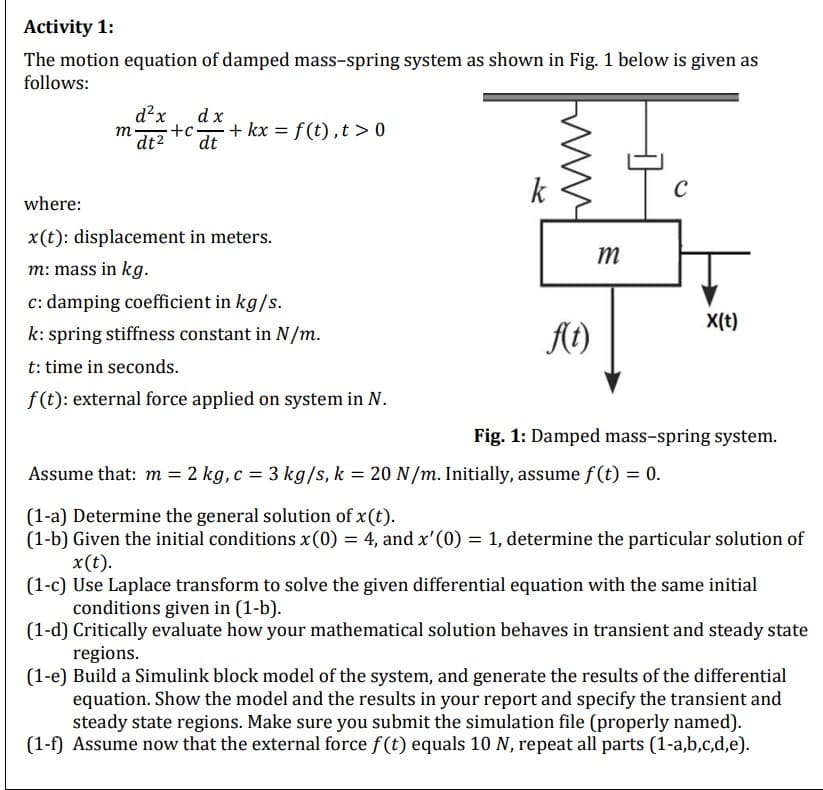Activity 1: The motion equation of damped mass-spring system as shown in Fig. 1 below is given as follows: dx d²x m +c+kx = f(t),t> 0 dt² dt where: x(t): displacement in meters. m: mass in kg. c: damping coefficient in kg/s. k: spring stiffness constant in N/m. t: time in seconds. f(t): external force applied on system in N. k f(t) m C Assume that: m = 2 kg, c = 3 kg/s, k = 20 N/m. Initially, assume f(t) = 0. X(t) Fig. 1: Damped mass-spring system. (1-a) Determine the general solution of x (t). (1-b) Given the initial conditions x (0) = 4, and x'(0) = 1, determine the particular solution x(t). (1-c) Use Laplace transform to solve the given differential equation with the same initial conditions given in (1-b). (1-d) Critically evaluate how your mathematical solution behaves in transient and steady sta regions. (1-e) Build a Simulink block model of the system, and generate the results of the differential equation Show the model and the results in your report and specify the transient and
Activity 1: The motion equation of damped mass-spring system as shown in Fig. 1 below is given as follows: dx d²x m +c+kx = f(t),t> 0 dt² dt where: x(t): displacement in meters. m: mass in kg. c: damping coefficient in kg/s. k: spring stiffness constant in N/m. t: time in seconds. f(t): external force applied on system in N. k f(t) m C Assume that: m = 2 kg, c = 3 kg/s, k = 20 N/m. Initially, assume f(t) = 0. X(t) Fig. 1: Damped mass-spring system. (1-a) Determine the general solution of x (t). (1-b) Given the initial conditions x (0) = 4, and x'(0) = 1, determine the particular solution x(t). (1-c) Use Laplace transform to solve the given differential equation with the same initial conditions given in (1-b). (1-d) Critically evaluate how your mathematical solution behaves in transient and steady sta regions. (1-e) Build a Simulink block model of the system, and generate the results of the differential equation Show the model and the results in your report and specify the transient and
Related questions
Question
1-F

Transcribed Image Text:Activity 1:
The motion equation of damped mass-spring system as shown in Fig. 1 below is given as
follows:
m
d²x
dx
-+c+kx = f(t), t> 0
dt² dt
where:
x(t): displacement in meters.
m: mass in kg.
c: damping coefficient in kg/s.
k: spring stiffness constant in N/m.
t: time in seconds.
f(t): external force applied on system in N.
k
f(t)
m
C
Assume that: m = 2 kg, c = 3 kg/s, k = 20 N/m. Initially, assume f(t) = 0.
X(t)
Fig. 1: Damped mass-spring system.
(1-a) Determine the general solution of x (t).
(1-b) Given the initial conditions x (0) = 4, and x'(0) = 1, determine the particular solution of
x(t).
(1-c) Use Laplace transform to solve the given differential equation with the same initial
conditions given in (1-b).
(1-d) Critically evaluate how your mathematical solution behaves in transient and steady state
regions.
(1-e) Build a Simulink block model of the system, and generate the results of the differential
equation. Show the model and the results in your report and specify the transient and
steady state regions. Make sure you submit the simulation file (properly named).
(1-f) Assume now that the external force f(t) equals 10 N, repeat all parts (1-a,b,c,d,e).
Expert Solution
This question has been solved!
Explore an expertly crafted, step-by-step solution for a thorough understanding of key concepts.
This is a popular solution!
Trending now
This is a popular solution!
Step by step
Solved in 4 steps with 3 images

Follow-up Questions
Read through expert solutions to related follow-up questions below.